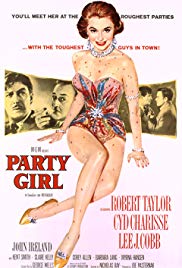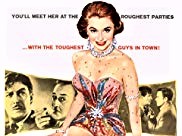Party Girl **** (1958, Robert Taylor, Cyd Charisse, Lee J Cobb, John Ireland, Kent Smith, Claire Kelly) – Classic Movie Review 8981
Director Nicholas Ray’s 1958 film noir gangster thriller Party Girl has a lot to offer: a gripping story (by Leo Katcher), a great mood and atmosphere, and fine performances, with acting lightweights Robert Taylor and Cyd Charisse well cast and the splendid Lee J Cobb outstanding.
The party’s intriguing guest list includes Taylor’s crooked lawyer Thomas Farrell, Charisse’s dancing moll Vicky Gaye and Cobb’s monstrous, unhinged gangster Rico Angelo.
Director Ray revels in the noirish toxic fumes of Chicago in the early Thirties, achieving an eerie, doom-laden atmosphere, though, unexpectedly, it is shot (by Robert J Bronner) in colour (Metrocolor) and a lot of the design is in the style of the Fifties.
Also in the cast are John Ireland, Kent Smith, Claire Kelly, Corey Allen, Lewis Charles, David Opatoshu, Kem Dibbs, Patrick McVey, Barbara Lang, Myrna Hansen, Betty Utey, Herb Armstrong, Marshall Bradford, Barrie Chase, John Damler, Michael Dugan, John Franco, Jack Gargan, Stuart Holmes, Sam McDaniel, Rusty Lane, Ken Perry, Dolores Reed, Benny Rubin, Floyd Simmons, Ralph Smiley, Sydney Smith, Vaughn Taylor, Carl Thayer, Geraldine Wall, Robert Williams and Erich von Stroheim.
Party Girl is directed by Nicholas Ray, runs 98 minutes, is made by Euterpe, is released by MGM, is written by George Wells, based on a story by Leo Katcher, is shot in Metrocolor by Robert J Bronner, is produced by Joe Pasternak, is scored by Jeff Alexander and André Previn, and is designed by William A Hornung and Randall Duell.
MGM was filming successfully outside its comfort zone. It cost $1,758,000 and was a hit, making MGM a profit of $454,000, thanks partly to its unusual higher gross overseas.
The title song Party Girl is written by Nicholas Brodszky (Music) and Sammy Cahn (Lyrics), and performed by Tony Martin.
Taylor was spotted by an MGM talent scout and given a contract in 1934 and his contract with MGM finally expired only in 1958 after Party Girl. After World War Two he joined the ultra-right-wing Motion Picture Alliance for the Preservation of American Ideals founded in February 1944 by Sam Wood and Walt Disney. He appeared as a friendly witness before the House Un-American Activities Committee.
Cobb was called before the House Un-American Activities Committee on charges that he was or had been a Communist. He named names and thus saved his career.
In the Forties Nicholas Ray joined the Theater of Action and later the Group Theater, and was active in the Socialist/ Communist movement.
© Derek Winnert 2019 Classic Movie Review 8981
Check out more reviews on http://derekwinnert.com



